Because engineering design is a service, it is necessary for you and your design team to also consider not only how the design presents a solution to a customer problem, but also what aspects of the design may raise concerns for the customer who may choose to purchase/adopt your product. One design tool that allows your team to simultaneously assess the customer and product considerations is Value Proposition Design.
What is Value Proposition Design?
Value Proposition Design is a method of product design that is featured in a well-respected product design text called Value Proposition Design: How to Create Products and Services Customers Want (Osterwalder, Pigneur, Bernarda & Smith, 2014) [7]. This method of design thinking explores what sort of benefits or elimination of drawbacks a potential customer can expect from using and/or owning your product or service. Ethics and engineering principles assert that in order for a product be considered a robust and effective use of time and resources, your design must make the completion of some task easier, faster, cheaper, and overall more accessible to the customer, without increasing the inconveniences or harms that the customer experiences.
Value Proposition Design clarifies what inconveniences and concerns the customer has with completing the task that your design aims to solve, as well as what benefits they seek to having those tasks completed better, faster, and cheaper with technology. Not looking “cool”, feeling embarrassed, or feeling out of fashion when using or owning your product for example might seem silly, but are very real considerations. While these concerns may not apply across all senior design projects, more major concerns such as personal safety when operating the product, the promise of a return on investment in owning the product, and home/community safety when storing the product are all aspects that your team has to consider. Moreover, Value Proposition Design analyzes a conceptual design and explores how its features align with what the customer expects of the product. Using this design method to validate the goals of your design team with your project strengthens the appropriateness of your design, and respects the customers’ right to have their concerns and expectations of your product.
Using the Value Proposition Design Tool: Constructing the Customer Profile
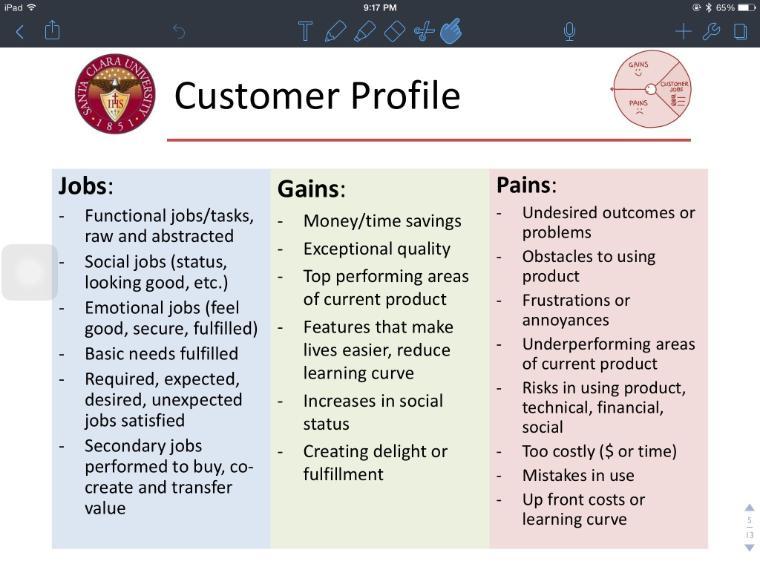
Figure 3: The customer profile jobs, gains, and pains breakdown chart. Courtesy of Dr. Chris Kitts, Santa Clara University [8].
Another useful design tool is the customer profile. The customer profile is a way to organize collected feedback from your interviewed customers. It allows for you and your team to compile customer comments to identify three different dimensions of customer concerns regarding existing design solutions to their problems, which are called “jobs”, “gains”, and “pains”[7].
- Jobs: These are the basic tasks, functions, and secondary features that your customer looks to have from your design solution. Additionally, a job can be the social and emotional benefits to owning or using your product that respect customer preferences and dignity (e.g. a sense of security, normalcy, privacy, personal hygiene).
- Gains: These are the benefits or positive outcomes experienced by the customer that relate to completing the jobs or tasks required by your design solution. (e.g., is fun, time efficient, saves them money, is the best existing product in that realm, simple user interface).
- Pains: These are negative outcomes, inconveniences, or harms experienced by the customer that relate to completing the jobs or tasks required by your design solution (e.g., requires a power cord, have to be a certain height to operate, amount of steps needed to complete job, amount of people needed to operate the device).
Mapping the customer profile helps product designers by enumerating explicit requirements and concerns of their customers.
1) Define what specific jobs are completed by existing products or processes that are relevant to your design.
- Functional concerns:
- Do existing design solutions require the customer to expend more time and resources, or resources that they do not have easy access to?
- Do existing design solutions match or exceed the efficiency or effectiveness of technology or methods currently used by your customers to solve their problem(s)? Why do they not own or like these existing design solutions?
- Social concerns:
- Do existing design solutions help your customer appear healthier? Smarter? Cooler? More financially well-off?
- Do existing design solutions carry any stigma or negative connotations for your customer within their culture/community?
- Do existing design solutions contribute to the loss of jobs within the community?
- Emotional concerns:
- Do existing design solutions allow your customer to feel healthier? Smarter? Cooler? More financially well-off?
- Do existing design solutions help your customer feel more secure or safer in their community? If not, what could be changed?
2) Define the benefits or gains that your customer would expect from existing products or processes that complete their jobs.
- Money/time savings:
- To what extent do existing design solutions lessen or eliminate monetary costs, limited resources, and time constraints restricting the customer/community’s ability to complete their jobs?
- Increased quality of job completion:
- How do existing design solutions increase the quality of the jobs completed by the customer or community in comparison to the methods or technology they currently use?
- Satisfaction, enjoyment, entertainment:
- Would owning existing design solutions decrease the laboriousness or level of difficulty in completing their requested jobs? If so, would it possibly increase the satisfaction or enjoyment they experience while doing so? Could it possibly make job completion a fun experience?
3) Define remaining pains regarding existing design solutions.
- Obstacles to using existing products:
- Does the customer not have the time or resources necessary to build, operate, or own similar products?
- Do existing design solutions present increased difficulty in usage for specific people in the community? (e.g, shorter people, people with disabilities, specific ethnic groups/different language speakers, uneducated/illiterate members of the community).
- Do existing design solutions have a steep learning curve to operate, or require an extensive amount of training from your customer?
- Frustrations or annoyances:
- Do existing design solutions require intense physical exertion? Multiple tries to operate?
- Do existing design solutions occupy an inconvenient or excessive amount of space? RAM?
- Do existing design solutions require the customer to relocate themselves in order for them to function?
- Risks:
- Are there any unaddressed safety hazards associated with building, operating, or owning existing design solutions?
- What information is required from customers from existing design solutions, and what are unaddressed risks of this information leaking or being stolen?
Using the Value Proposition Design Tool: Constructing the Product Profile
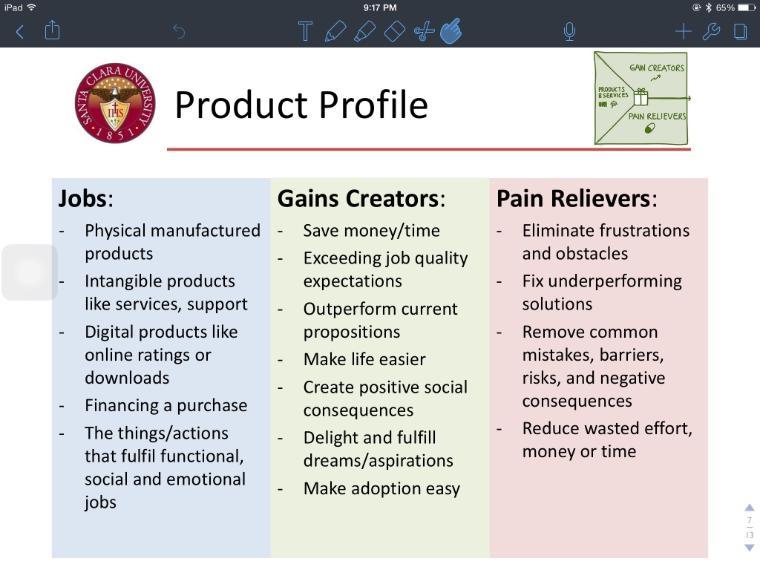
Figure 4: The product profile jobs, gain creators, and pain relievers breakdown chart. Courtesy of Dr. Chris Kitts, Santa Clara University [8].
While the customer profile looks at what the customer is expecting from the product, the product profile maps out the specific aspects of your team’s design that complete jobs required by the customer. It also maps what aspects of the design create additional value and relieve user inconveniences, which are called “gain creators” and “pain relievers”. The product profile is used to help designers find what merits and problems are present in their product [7].
- Product Jobs: These are aspects of your design solution that fulfill basic tasks, functions, and secondary features that your customer looks to have from your design solution. Additionally, a product job can be considered social and emotional benefits that owning or operating the product does for the customer (e.g., wi-fi connectivity, free tech support, voice command).
- Gain Creators: These are the benefits or positive outcomes that a customer can experience from owning or operating your design. (e.g., looking cool, “Shape-Up” shoes that tone your body while you walk, provides clean water without boiling, saves time/money, can be easily operated without training).
- Pain Relievers: These are the possible negative outcomes, inconveniences, or harms that are eliminated for the customer by owning or operating your design. (e.g., saves a trip to the store, saves user information so that it doesn’t have to be entered in multiple times, GPS navigation that keeps you in well-lit areas during the evening, “Grammarly” ensures that your grammar and spelling are checked as you type, self-cleaning devices).
After mapping the customer profile, your team can form the product profile based on what specific concerns voiced by the customer will be addressed by your design solution.
1) Define what jobs would be completed by owning or operating your design solution:
- Primary jobs:
- Does your product do what is expected of it by your customer? How does it do it better than other existing products or processes?
- Auxiliary services:
- What additional jobs are completed by owning or operating your product that other existing solutions do not fulfill or do as well?
- Emotional/social benefits:
- How does your design solution offer a stronger sense of fulfillment, security, and confidence to your customer than other existing products?
2) Define what benefits or gains expected by the customer would be fulfilled by your design.
- Money/time savings (efficiency):
- To what extent would your design solution lessen or eliminate monetary costs, limited resources, and time constraints restricting the customer/community’s ability to complete their jobs?
- Increased quality of job completion (makes life easier):
- How does your design increase the quality of the jobs completed by the customer or community?
- Satisfaction, enjoyment, entertainment (positive social outcomes):
- Would owning or operating this product decrease the laboriousness or level of difficulty in completing their requested jobs? If so, would it possibly increase the satisfaction or enjoyment they experience while doing so? Could it possibly make job completion a fun experience?
3) Define what explicit pains and concerns of your customers would be lessened or eliminated by your design solution.
- Frustrations and obstacles to job completion:
- What specific steps, processes, or functions are made less frustrating or otherwise inconvenient for your customer by your design solution? How does this set it apart from existing design solutions?
- Reduction of time, effort, and resources expended:
- Does owning or operating your design solution greatly reduce the amount of time, effort, or resources used by your customer in completing their jobs? How does this set it apart from existing design solutions?
Using the Value Proposition Design Tool: Analyzing the Customer-Product Fit
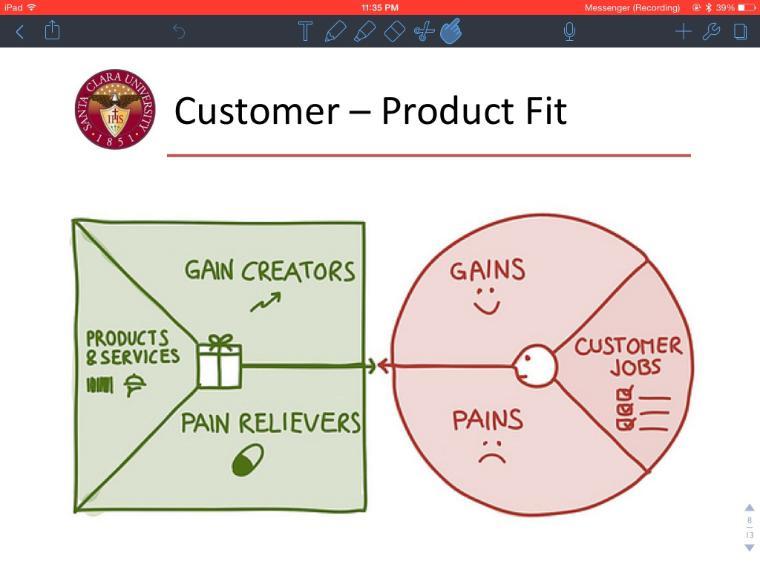
Figure 5: The Customer-Product Fit Diagram. Courtesy of Dr. Chris Kitts, Santa Clara University [8].
When your team maps out both the customer and product profiles, you can revisit and iterate upon the design by exploring what is called the Customer-Product Fit. Engineers using Value Proposition Design look to take the jobs, gain creators, and pain relievers offered by their design solution and see how well they satisfy customer concerns about the benefits and pains that come from completing tasks and jobs the design seeks to improve upon [7].
Being able to identify what concerns are addressed by each aspect of your design serves to distinguish your design solution from other competitors, making it a more attractive prospect to your potential customers. More than validating the functions and features of your product, however, it also respects customers rights by providing them a stronger voice in how your technological solution will change the way they live.
A good Customer-Product Fit is achieved when the product:
- Addresses important jobs identified by the customer.
- Creates essential gains or benefits by owning/using the product.
- Alleviates significant pains, inconveniences, or harms.
Areas that might be addressed in mapping your Customer-Product Fit include:
- Product and lifestyle (Rights to comfortable living):
- How does your product change, adapt to, and improve a customer’s lifestyle? How does it make their daily lives easier? (e.g., right turn signal camera makes it safer to change lanes, “Fit-Bit” tracks steps and rewards users, “Cutco” cutlery makes food preparation faster, voice-to-text feature for hands-free messaging).
- Product and occupation (Rights to comfortable work):
- How does your product significantly decrease the inconveniences, harms, or dangers associated with the customer’s occupation? How does it make the jobs or tasks that they complete easier? (e.g., power line maintenance workers, construction workers, mining, contact sports players’ gear).
- Product and socioeconomic status (Rights to equity):
- How does your product make it easier for people to access basic amenities? (e.g., clean water, air, plumbing, refrigeration/heat, quiet, lighting/electricity, shelter).
- Product and demographics (Rights to equality):
- Should your product be adaptable and appropriate for people of different age groups? Different cultures? Different religious communities? (e.g., the Nintendo Wii being appropriate play for all ages, Skype makes it possible for people to communicate with just wi-fi connection, religious text applications on smartphones).
- Product and work/operation environment (Rights to safe and resilient technology):
- How will your product be able to function and remain undamaged in different environments? (e.g. colder, hotter, drier, wetter, hilly, seaside, rural, urban environments)
- Does your product extend the rights, comfort, and autonomy of individuals with physical and mental disabilities? (e.g., quiet fidgets for students, self-stabilizing cutlery for people with Parkinson’s, braille computer keyboards for the blind, visual translators for sign language).
- Product and disability (Rights of people with disabilities):
Personal Link
It is immensely helpful in the senior design process,to work as closely as you can with a client or group of people that could be considered “potential customers” who would benefit from your product if it were to be produced. Being able to communicate with a customer throughout the design process helps your team more easily navigate each aspect of Value Proposition Design, as each design decision your team makes can be easily validated and critiqued before implementation.
These design elements came into play in my time working on the Frugal Clay Press for Nicaragua senior design project, which was a project to design a clay press for a brick making social entrepreneurship located in Ciudad Darío, Nicaragua. A great example of how Value Proposition Design was used in my senior design project was in the design of our clay compression chamber. The community that we worked with did not compress their clay in order to make bricks, which made brick-making a long and delicate process. Our customer had two main concerns regarding our design: that our compression chamber would only produce two bricks at a time, and that it may not allow the clay to maintain its shape. We proposed that owning and operating our clay press would not only increase the mechanical processes of the bricks through compression, but would also enable the formed bricks to dry much faster. Moreover, we conducted tests on clay at Santa Clara University and on-site during our spring break exploratory visit to Nicaragua to verify the merits of compressing clay for brick making.
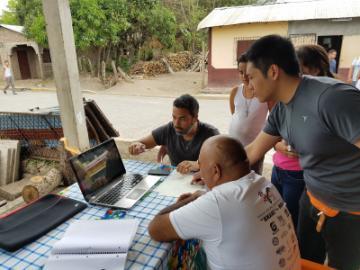
Figure 6: In-person Voice of Customer assessment interviews I conducted while in Ciudad Darío, Nicaragua in March of 2018.
What we produced in our tests were bricks that were much stronger and absorbed less water than the bricks that they made. While our customer still voiced concern for the machine only producing two bricks at a time, our tests on the local clay showed that the bricks produced by our design would be of a higher quality. Additionally, compression of the clay using our device allowed for the customer to use less water in mixing the clay, as water usage was a significant expense in their production costs. By having our customer actively contributing to the development of our design during the design process, we were able to make changes to the design that made it more appropriate for our customer and community.
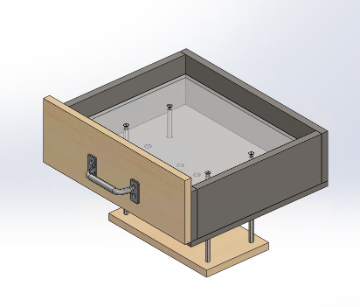
Figure 7. 3D model of the Compression Chamber subsystem for the Frugal Clay Press for Nicaragua design project. Authored by L. Isaac Marcia.
References:
[7] Osterwalder, Alexander, et al. Value Proposition Design: How to Create Products and Services Customers Want. John Wiley & Sons, 2014.
[8] Kitts, Christopher. “Value Proposition Design.” MECH 144: Smart Product Design. MECH 144 Lecture 12, 16 May 2017, Santa Clara, California, Bannan Engineering.
